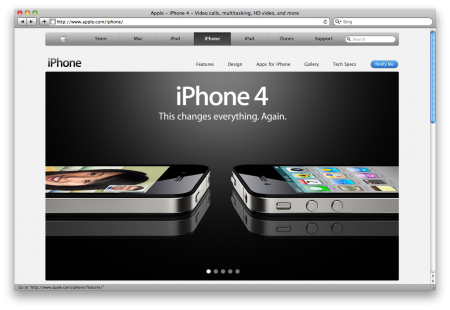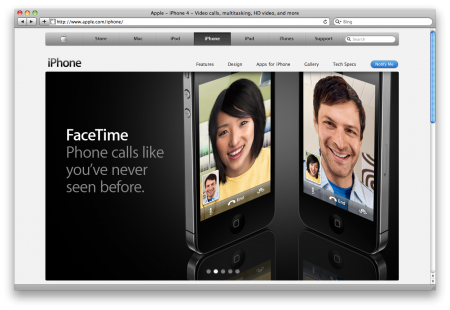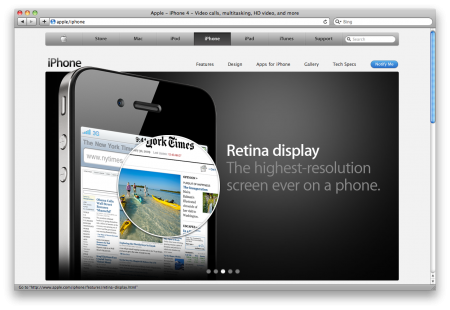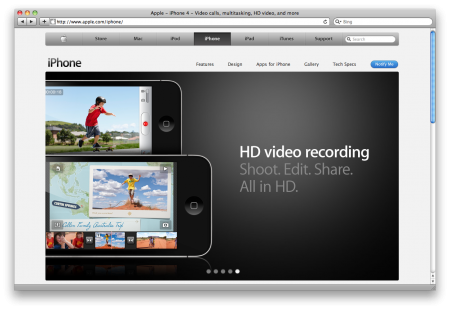It cannot be doubted that the new design for the iPhone is lovely. While some may prefer the curved aesthetics of the 3G/3GS, I preferred the flat back of the original iPhone and the iPhone 4 seems to hark back to that instantly recognisable design. The buttons are a welcome change from the rocker though I have to wonder who the + and – sign will appeal to (but more on that later). The fact the unit is thinner is not quite as amazing as some might make out – the 3Gs was curved and tapered towards the edges. When you eliminate some of that curve, then it’s not a considerable amount of space being removed – pretty standard for a year’s worth of development.
It’s a lovely design, surprisingly small and explains why the iPad fits so much battery into it’s design as they are, for the most part, the same hardware.
FaceTime is a curious beast. It runs over a normal cell call while (currently) routing the video data over WiFi which means that video-conference call over any distance will end up being pretty much the same as a normal voice call. Hopefully it will use your free minutes locally but it will also not be cheap calling internationally. I would hope that someone will take the FaceTime specification and make a compatible app that permits data-only calls. I have a feeling that with the reductions in cellular download limits and the statement from Skype that they’re going to be charging for Skype-Skype calls over 3G, we’re being nickel-and-dimed by our carriers and services.
Will I use FaceTime? It’s looking unlikely as I’m no longer sure who will have an iPhone 4 that I also want to have “face time” with?
This will be welcome as I do use my iPhone for reading eBooks – something I have not used the iPad for (bizarrely). Anything that improves the quality of the text is welcome but I’m also not going to stress out about it. It’s not what I’d consider a killer feature. The unit allegedly has a better graphics chip which is going to be needed to push those extra pixels and it shows that ‘iOS’ is moving towards resolution independence faster than the Mac.
One of the most demanded features and remaining one of the most controversial. Proper multi-tasking is only going to be enabled for Voice Over IP, Music Streaming Services and Location Service updates. While these are indeed awesome, I would have also included a voice recording option as well. Being able to record a meeting while doing something else is an extremely useful feature and some apps, like Audiotorium, really need it – I would assume there are some VoIP supporting features which could enable this. The other multitasking bits and pieces, like local notifications and ‘background task completion’ offer 95% of what people really want with multi-tasking.
All in all, I welcome our new multi-tasking masters.
The camera in the iPhone 4 is meant to be much better but I still have one serious issue with the camera in the iPhone and that’s the soft-button for taking pictures. This is a pain in the butt especially when there are three buttons on the device in almost the right place which are all unused when taking pictures.


Would it be too much to ask that while the Camera app is running to make those useless buttons actually do something? Like control zoom or maybe take the picture? At the moment I feel like I need three hands to work the iPhone camera – two to hold it, one to actually take the shot. And god forbid you should want to take a picture of yourself (while in a bar, late at night, with drunk friends), it just makes life difficult managing that soft-button.
What else is notable?
The storage is the same as the 3GS. 16 or 32 GB versions. It seems odd they didn’t upgrade to 64 GB but I think it’s because they’re finding that in iPod touch and iPad, people are trending towards the 32 GB version anyway. It seems to be some sort of in-pocket-storage sweet spot. Google and HTC should take note.
It’s rumoured that the iPhone 4 has 512 MB RAM rather than the 256 MB RAM found in the 3GS and iPad. That’s going to make a difference for Safari which often has a forced reload when using some memory-hungry pages.
Also, the range of acceptable frequencies is interesting. Compare the 3GS to the iPhone 4. I have no idea what this means (though I entertained the idea that the iPhone 4 would support 3G service on T-Mobile USA opening the door to another GSM carrier in the US but it seems to be more related to Band VIII (W-CDMA 900) in Europe, Asia, Australia, New Zealand and Venezuela. I’m no specialist when it comes to mobile telecoms obviously but that one little item of difference looks like it’s been added to increase worldwide compatibility. I can’t see the iPhone breaking away from AT&T soon (and it’s been said many times that Sprint/Verizon would not have such a good network with 20 million iPhone users on it).
| iPhone 3GS | iPhone 4 | |
|---|---|---|
| UMTS/HSDPA | 850, 1900, 2100 MHz | 850, 900, 1900, 2100 MHz |
| GSM/EDGE | 850, 900, 1800, 1900 MHz | 850, 900, 1800, 1900 MHz |
There’s some more stuff but it’s all NDA’ed at the moment and I’ve not seen anyone else talking about it. So I won’t.
Pre-order starts today for the iPhone 4 but rumours indicate that the white model is going to be severely constrained. As I leave in three days for my family holiday and won’t be back until July, I won’t be pre-ordering even though I do see an iPhone 4 in my future. Arlene, in contrast, doesn’t find it desirable – but this is something she has dithered about over the previous 3 generations on iPhone and I reckon this will be the same. It’s a solid upgrade and it’s interesting what they chose to concentrate on. There’s no real difference in the hardware ‘features’ and someone will always think another phone is better because it has an FM radio or a built-in TV receiver but those sorts of niche features don’t remotely interest me.
Are you planning to get the new iPhone 4?













